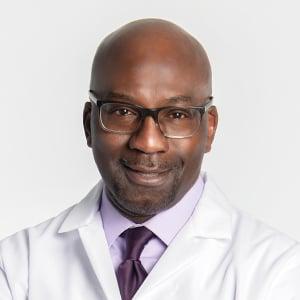On Sept. 16, the American Association for Cancer Research (AACR) released its inaugural Cancer Disparities Progress Report — and they have pulled no punches. In it, they describe the devastating gap in cancer treatment and outcomes based on race, ethnicity, socioeconomic status, sexual orientation and more. The report also includes a special section on COVID-19.
On the steering committee for this groundbreaking report was City of Hope’s Rick Kittles, Ph.D., director of the Division of Health Equities in the Department of Population Sciences. Kittles, an expert in genomic research, has long focused on understanding the complex issues surrounding race, genetic ancestry and health disparities.
Of major concern is the group most affected by these inequalities, the African American community.
“It’s not OK that in the U.S., African Americans have had the highest overall cancer death rate for more than four decades,” said Kittles. “We need to recognize the systemic, gross health disparities in our nation, health care system and medical research, which does not have enough representation from the Black community.”
The report details the disparities for African Americans as well as many other groups, highlights areas where some progress has been made, and lays out the paths toward significant solutions.
Some Shocking Statistics
These selected statistics provide some enlightening examples of what the report found — and the discrepancies are dramatic.
- African American men have a 111% higher risk of dying from prostate cancer than whites.
- African American women are 39% more likely to die from breast cancer compared to whites.
- Asian/Pacific Islander adults are twice as likely to die of stomach cancer than whites.
- Native Americans and native Alaskans are twice as likely to develop liver and bile duct cancer.
- Men living in Kentucky are 3.5 times more likely to have and die from lung cancer than those living in Utah.
- The survival rate for uninsured people with a type of liver cancer known as hepatocellular carcinoma is less than half as long as those with insurance.
- In the poorest U.S. counties, men with colorectal cancer have a 35% higher death rate than men in the most affluent counties.
- Bisexual women are 70% more likely to be diagnosed with cancer than heterosexual women.
The statistics are equally telling for COVID-19, with hospitalization and mortality rates enormously higher among people of racial and ethnic minorities than among the white population.
Some progress toward closing this health gap has been made. In 1990, the cancer death rate for African Americans was 33% higher than the death rate for whites. In 2016, it was 16% higher. An improvement, yes — but still a huge discrepancy.
As with everything related to cancer, the factors contributing to these disparities are complex. Some may be genetic, some are related to gaps in medical research due to lack of diversity among study subjects, and others are lifestyle choices that can be modified for better health outcomes.
Some Factors Are Preventable
About 40% of adult cancers can be prevented when people modify certain behaviors — tobacco use, excess body weight, lack of exercise, alcohol consumption, and sun and UV exposure.
Regular screening for breast, cervical, colorectal and prostate cancers — as well as certain strains of cancer-related human papillomavirus — are also important, but these screenings are less likely to occur among the groups studied.
The report calls for new strategies in education and intervention to reduce the incidence of cancer in the U.S., while a deeper look at the problem also revealed more complicated issues.
Socioeconomic Status and Cancer
The report also examines the question of socioeconomic status and cancer — an area that often overlaps with racial and ethnic minorities. It’s a subject Loretta Erhunmwunsee, M.D., a City of Hope thoracic surgeon, has studied extensively.
Her research has shown how socioeconomic status, high-poverty neighborhoods and low educational levels are all linked to higher death rates in certain types of cancers.
“Social factors have a significant impact on cancer health disparities. The report reminds us that up to ‘34% of cancer deaths could be prevented if socioeconomic disparities were eliminated.’ This finding suggests that we must address social determinants if we are going to eliminate disparities,” she said.
Her work has also proven that these factors directly affect cancer outcomes.
“Research has shown that individuals living in disadvantaged neighborhoods are more likely to be diagnosed with late-stage cancer and to have poorer survival compared with individuals in more advantaged neighborhoods,” Erhunmwunsee explained. “We therefore have to consider our patients’ physical environment and their exposure to pollution as we care for them. Ignoring these factors will contribute to worsening disparities.”
Further Inequities in Treatment, Research
Apart from the impact of socioeconomic factors in accessing screening and health care, there are issues directly related to treatment and research that need to be addressed.
Enormous breakthroughs are now being made in cancer research — many involving new precision medicine based on biological, environmental and lifestyle factors unique to each individual patient.
Like all advances, these are based on scientific studies. The report points out, however, that the subjects for most of these studies are white, so that the genetic differences of minorities are often not considered.
This is one of the areas Kittles is working hard to change.
“We are now able to genetically screen many tumors and use the information to make better clinical decisions for patients. Yet, the majority of the data on cancer-associated mutations come from white people,” he said. “So many of these breakthrough new treatments may not be as effective for Black people and Latinos, who arguably need it more than other groups to continue to close the health disparity gap.”
Fortunately, the patient population at City of Hope is quite diverse, comprised of people from many different ethnic backgrounds, providing an excellent pool of subjects for the many advanced studies that take place here.
The Economics of Health Disparities
The report calls for major funding increases for federal agencies and programs working to reduce cancer health disparities — and it also points out that in time the fiscal savings would be significant.
They looked at the financial toll of health disparities from 2003 to 2006, and found that eliminating such disparities would have a powerful impact — reducing direct medical costs by about $230 billion, and the costs associated with illness and premature death by more than $1 trillion.
A National Priority
The AACR laid out a powerful vision in their report, and their description of what they hope to achieve is worth quoting:
“By making sure that cancer health disparities research is a national priority, Congress can help us transform cancer care for all people, regardless of their race, ethnicity, age, gender, sexual orientation, socioeconomic status or the communities in which they live. When this support is coupled with increased collaboration among all stakeholders, achieving the bold vision of health equity will become a reality.”
AccessHopeTM, a wholly owned subsidiary of City of Hope, is working to reduce cancer health disparities in underserved populations. Read more.


